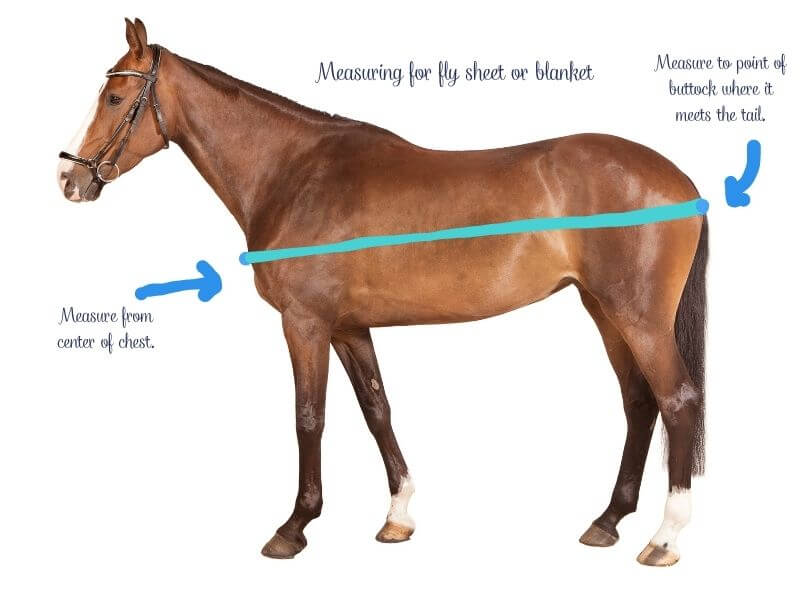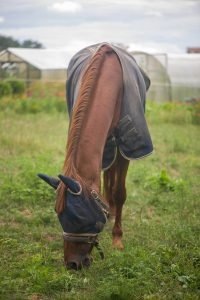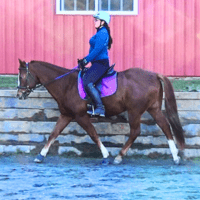I’m here to share how to measure your horse for a fly sheet so you get the right fit, which is important for your horse’s comfort.
Fly sheets are essential for most horses in the late spring, summer and early fall. Not only do they protect against pesky flies and mosquitos, but they also shield our equine friends from the strong UV rays.
Fly sheets come in various styles, materials, and sizes, and measuring your horse correctly is crucial for ensuring your horse is comfortable and the fly sheet can do its job correctly.
A fly sheet that doesn’t fit can not only cause rubs and get tangled when the horse rolls but it can also allow bugs to more easily get under the fly sheet.
So let’s get measuring so you can get the proper sized fly sheet!
If you’re looking for the best fly sheets for horses, check out this post on Joyful Equestrian: 7 Best Fly Sheets for Horses: Plus Special Sized Fly Sheets.
Table of Contents
Preparing to Measure
Before we get started, here’s what you’ll need:
- A friend (because everything’s better with a buddy, right?)
- A cloth tape measure (pro tip: avoid metal, as it can spook your horse)
- Pen and paper (old school, but it works)
- A calm and comfortable horse (no one wants to measure a jittery, unhappy equine)
How To Measure Horse For Fly Sheet
Now, let’s get down to business. Follow these steps to measure your horse for a fly sheet:
1. Start at the center of the chest:
Place one end of the cloth tape measure at the horse’s mid-chest, right where the neck meets the body.
2. Walk and unfold the tape measure down the side:
Keep the tape measure level and parallel to the ground, walking alongside your horse as you go.
3. Measure up to the point of the buttocks:
Where the cheek meets the tail (the top of tail), that’s your stop! Note the measurement in inches, and remember, accuracy is key. If your not sure where the point of the buttocks are check out my the diagram of the parts of the horse.

When measuring, make sure the tape measure is taut but not constricting. Also, be mindful of the horse’s withers, shoulder area, and the widest part of their body, as these areas can affect the fly sheet’s fit and comfort.
Determining the Fly Sheet Size
Using your horse’s true size, it’s time to choose the appropriate fly sheet.
Keep in mind that sizing may vary between brands, so it’s best to check out product reviews or consult a horse blanket buying guide to make an informed decision.
Remember, trial and error is part of the process, and don’t be afraid to return a fly sheet if it doesn’t fit correctly.
Be on the lookout for signs of discomfort, such as shoulder rubbing, bunched up fabric, or a stifled, shorter stride. You want the front closure of the fly sheet to overlap, but you don’t want it to be hanging down on the chest.
A well-fitting fly sheet should allow for freedom of movement, have adjustable straps (think belly straps, leg straps, and chest closures), and offer adequate coverage without constricting your horse.
Additional Fly Sheet Tips

Consider the Horse’s Build
Every horse is unique, so think about your horse’s conformation when choosing a fly sheet.
Some horses may need extra space in the shoulders or some horses may need a higher neck for upright shoulders or high withers, and others might benefit from gussets for freedom of movement.
Consider the Material of the Fly Sheet
Choose a fabric that’s comfortable, durable, and suitable for your horse’s needs. Whether they need a finer mesh to keep out gnats causing sweet itch or they need a very breathable sheet with good airflow for very hot weather, or a tougher material for the rougher playful horse.
These are things to keep in mind when picking out your horse’s fly sheet.
Color and style
While it may not affect the fit, choosing a fly sheet in your favorite color or design can add a touch of personality to your horse’s wardrobe and it’s fun.
Some fly sheets even come in patterns like foxes, ice cream cones, and pineapples.
Conclusion
There you have it, folks! Measuring your horse for a fly sheet doesn’t have to be a daunting task.
With a little preparation, a keen eye, and some patience, you’ll be well on your way to finding the perfect fly sheet for your trusty steed.
Just remember: a comfortable, well-fitting fly sheet equals a happy horse!
Now that you’re a fly sheet measuring pro, don’t forget to share your newfound knowledge with your fellow horse owners.
| Key Takeaways |
|---|
| 1. Importance of fly sheets for protection against insects and UV rays |
| 2. Accurate measurement crucial for proper fit and protection |
| 3. Measure horse: start at center of chest, unfold tape measure down the side, measure to the point of the buttocks |
| 4. Determine fly sheet size considering horse’s build, material, color, and style |
| 5. Well-fitting fly sheets should allow freedom of movement and have adjustable straps |
| 6. Take into account horse’s conformation and needs when selecting material and style |
| 7. Add personality to horse’s wardrobe with fun colors and designs |
Have you experienced any challenges when measuring your horse for a fly sheet? Share your tips and tricks for overcoming them.
Cheers, Kacey
P.S. Did you like this article? Gallop over to:

